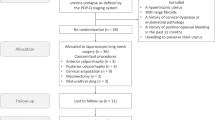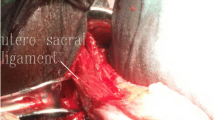Abstract
Introduction and hypothesis
In this study, we provide a description of laparoscopic uterine suspension technique through round ligament.
Methods
From 1997 to 2010, 55 patients with uterine prolapse were treated by laparoscopic uterine suspension. It is performed by suturing and tying a 1-0 Ethibond on the left round ligament at its insertion into the uterus. Then curved forceps pass the lateral puncture wound into the extraperitoneal space along the round ligament and penetrates the anterior leaf of the broad ligament into the peritoneal cavity and grasps the free ends of the Ethibond. They are withdrawn extraperitoneally along the round ligament then tightly tied at the fasciae on either side of the lateral puncture wound.
Results
Forty-two out of 55 patients (76.4%) experienced a reduction of prolapse to stage 0, regardless of what stage they started from. Twelve out of 55 (21.8%) experienced a reduction of prolapse varying from one to two stages. One out of 55 (1.8%) experienced no reduction in prolapse.
Conclusions
This technique reconstructs a new, inelastic round ligament.


Similar content being viewed by others
Abbreviations
- ASIS:
-
Anterior superior iliac spine
- LLQ:
-
Left lower quadrant
References
Olsen AL, Smith VJ, Bergstorm JO, Colling JC, Clark AL (1997) Epidemiology of surgically managed pelvic organ prolapse and urinary incontinence. Obstet Gynecol 89:501–506
Diwan A, Rardin CR, Kohli N (2004) Uterine preservation during surgery for uterovaginal prolapse: a review. Int Urogynecol J 15:286–292
Maher C, Feiner B, Baessler K, Adams EJ, Hagen S, Glazener CM (2010) Surgical management of pelvic organ prolapse in women. Cochrane Database Syst Rev 4:CD004014
Lin LL, Ho MH, Haessler AL, Betson LH, Alinsod RM, Liu CY, Bhatia NN (2005) A review of laparoscopic uterine suspension procedures for uterine preservation. Curr Opin Obstet Gynecol 17:541–546
O’Brien PM, Ibralim J (1994) Failure of laparoscopic uterine suspension to provide a lasting cure for uterovaginal prolapse. Br J Obstet Gynaecol 101:707–708
Candy JW (1976) Modified Gilliam uterine suspension using laparoscopic visualization. Obstet Gynecol 47:242–243
Mann WJ, Stenger VG (1978) Uterine suspension through the laparoscope. Obstet Gynecol 51:563–566
Massouda D, Ling FW, Muram D et al (1987) Laparoscopic uterine suspension with Falope rings. J Reprod Med 32:859–861
Gordon SF (1992) Laparoscopic uterine suspension. J Reprod Med 37:615–616
Bump RC, Mittiasson A, Bo K, Brubaker LP et al (1996) The standardization of terminology of female pelvic organ prolapse and pelvic floor dysfunction. Am J Obstet Gynecol 175:10–17
Abrams P, Cardozo L, Fall M et al (2002) The standardisation of terminology of lower urinary tract function: report from the standardisation sub-committee of the International Continence Society. Neurourol Urodyn 21:167–178
Ostrzenski A (1998) Laparoscopic retroperitoneal hysteropexy. A randomized trial. J Reprod Med 43:361–366
Carter JE (1999) Carter-Thomason uterine suspension and positioning by ligament investment, fixation and truncation. J Reprod Med 44:417–422
Gargiulo T, Leo L, Gomel V (2000) Laparoscopic uterine suspension using three-stitch technique. J Am Assoc Gynecol Laparosc 7:233–235
Batioglu S, Zeyneloglu HB (2000) Laparoscopic plication and suspension of the round ligament for chronic pelvic pain and dyspareunia. J Am Gynecol Laparosc 7:547–551
Ou CS, Liu YH, Joki JA, Rowbotham R (2002) Laparoscopic uterine suspension by round ligament plicaiton. J Reprod Med 47:211–216
Perry CP, Presthus J, Nieves A (2005) Laparoscopic uterine suspension for pain relief: a multicenter study. J Reprod Med 50:567–570
Whiteside JL, Barber MD, Walters MD, Falcone T (2003) Anatomy of ilioinguinal and iliohypogastric nerves in relation to trocar placement and low transverse incisions. Am J Obstet Gynecol 189:1574–1578
Conflicts of interest
None.
Author information
Authors and Affiliations
Corresponding author
Rights and permissions
About this article
Cite this article
Hsieh, CH. A new laparoscopic technique for uterine prolapse: one-sided uterine fixation through the round ligament. Int Urogynecol J 22, 213–219 (2011). https://doi.org/10.1007/s00192-010-1269-z
Received:
Accepted:
Published:
Issue Date:
DOI: https://doi.org/10.1007/s00192-010-1269-z




